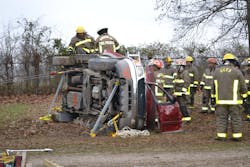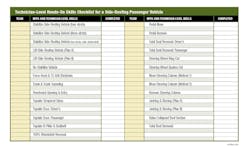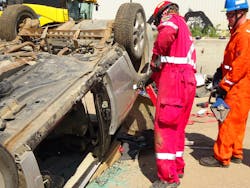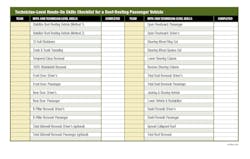University of Extrication: Extrication Training on Side- and Roof-Resting Passenger Vehicles
Topic: Technician-level hands-on skills checklist
Objective: Complete technician-level hands-on skills
Task: The rescue team shall complete all skills that are on the technician-level checklists
As I have said and written before, the people who run trainings on vehicle rescues (training officers, rescue crew chiefs and instructors) must ensure via their preparation that the extrication skills that crewmembers take away from those trainings are hands-on applicable to real-world situations. (Of course, training should comply with national, state and agency standards.) As I also have said and written before, training officers, rescue crew chiefs and instructors should be dedicated to getting the absolute most skills training value as possible out of every donated, acquired vehicle.
This University of Extrication column provides two checklists to guide instructors for conducting challenging, technician-level, hands-on vehicle rescue training sessions. Participants must be told that the sequence of tasks isn’t intended for handling an actual entrapment incident but rather is a means of getting the most value from acquired vehicles during training.
Each of these checklists is intended to be printed out and used as a hardcopy document during the drill session. Once the training session is complete, the signed and dated checklist defines exactly what advanced hands-on skills the participating crewmembers accomplished at that place and time. This can be of great benefit during a future litigation situation.
Particulars
For the purposes of conducting NFPA-compliant hands-on vehicle rescue skill sessions, your agency, as the authority having jurisdiction (AHJ), must establish that a passenger vehicle that weighs less than a specific weight is a common vehicle that’s found within the boundaries of your jurisdiction. I selected a gross vehicle weight rating (GVWR) of 10,000 lbs. as the distinction between a “common vehicle” (Chapter 8) and a “heavy vehicle” (Chapter 9) in NFPA 1006: Standard for Technical Rescue Personnel Professional Qualifications (2021 edition).
A GVWR of no more than 10,000 lbs., for example, conveniently includes passenger coupes and sedans, minivans, full-size vans, SUVs, CUVs (crossovers) and pickups, including some so-called dualies.
Although required job performance skills and knowledge is listed within Chapter 8 and Chapter 9 of NFPA 1006, the specific extrication tasks to meet these competencies aren’t. This is where the two checklists can be of great value.
Training officers, rescue crew chiefs and instructors should know that rescue training tasks that are completed on common passenger vehicles that rest on their four wheels on a level surface are considered operations-level competencies. Although rescue training tasks that are completed on passenger vehicles that rest on their roof or one of their sides are included in Chapter 8, they are covered under the technician-level competencies.
Prior to starting the training, the acquired passenger vehicle must be checked for potential hazards. All of the vehicle’s undeployed supplemental restraint airbags must be deployed. After this, a smokehouse rescue dummy can be seated and belted in the driver’s seat.
At that point, all doors are closed and locked, and the vehicle is tipped onto the driver’s side or rolled onto its roof.
Next, rescue tools should be placed in a tool area, all safety guidelines should be explained, and participants should be arranged into working crews.
After training on the side-resting skills is completed, the participants can rehab and then begin working on the training on roof-resting skills and vice versa.
Three lines of “Technician-Level Hands-On Skills Checklist for a Side-Resting Passenger Vehicle” (above) deal with stabilization. This is so different crews work with their own individual limitations in regard to the number of struts that are used. The final stabilization/strut skill assignment makes one side of the vehicle “side-obstructed.” Not only is the assignment to be carried out via two struts, but it must incorporate other equipment, too, because of the “obstruction” to the side of the automobile that isn’t against the ground.
Lifting a side-resting vehicle—the two tasks on the checklist after stabilization—should be completed by different crews using different equipment that’s available to them—as indicated by “Plan A” and “Plan B.” Each time, the crew starts with the vehicle in ground contact. This isn’t an easy assignment, but the scenario is a realistic possibility in the real world.
Similar to above, “Technician-Level Hands-On Skills Checklist for a Roof-Resting Passenger Vehicle” (below) has two lines for stabilization: again, to facilitate the use of different methods.
To accomplish the two floorboard-opening assignments on one vehicle, the first crew opens the floor on one side of the vehicle, leaving the other side of the floorboard for the second crew.
Roof- & Side-Resting Training
- Acquired passenger vehicles “safety checked” and positioned
- Participants organized into crews and designations assigned
- Safety orientation conducted
- Side-resting skills assigned and completed
- Rest and rehabilitation period
- Roof-resting vehicle skills assigned and completed
About the Author
Ron Moore
RON MOORE, who is a Firehouse contributing editor, recently retired as a division chief with the McKinney, TX, Fire Department and now serves with Prosper, TX, Fire Rescue. He self-published the Vehicle Rescue 1-2-3 training manual and serves as the forum moderator for the extrication section of Firehouse.com . Moore can be contacted directly at [email protected].




